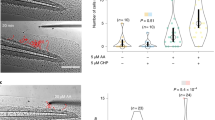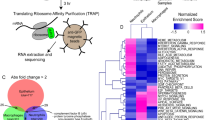Abstract
Barrier structures (for example, epithelia around tissues and plasma membranes around cells) are required for internal homeostasis and protection from pathogens. Wound detection and healing represent a dormant morphogenetic program that can be rapidly executed to restore barrier integrity and tissue homeostasis. In animals, initial steps include recruitment of leukocytes to the site of injury across distances of hundreds of micrometres within minutes of wounding. The spatial signals that direct this immediate tissue response are unknown. Owing to their fast diffusion and versatile biological activities, reactive oxygen species, including hydrogen peroxide (H2O2), are interesting candidates for wound-to-leukocyte signalling. Here we probe the role of H2O2 during the early events of wound responses in zebrafish larvae expressing a genetically encoded H2O2 sensor1. This reporter revealed a sustained rise in H2O2 concentration at the wound margin, starting ∼3 min after wounding and peaking at ∼20 min, which extended ∼100–200 μm into the tail-fin epithelium as a decreasing concentration gradient. Using pharmacological and genetic inhibition, we show that this gradient is created by dual oxidase (Duox), and that it is required for rapid recruitment of leukocytes to the wound. This is the first observation, to our knowledge, of a tissue-scale H2O2 pattern, and the first evidence that H2O2 signals to leukocytes in tissues, in addition to its known antiseptic role.
This is a preview of subscription content, access via your institution
Access options
Subscribe to this journal
Receive 51 print issues and online access
$199.00 per year
only $3.90 per issue
Buy this article
- Purchase on Springer Link
- Instant access to full article PDF
Prices may be subject to local taxes which are calculated during checkout



Similar content being viewed by others
References
Belousov, V. V. et al. Genetically encoded fluorescent indicator for intracellular hydrogen peroxide. Nature Methods 3, 281–286 (2006)
Bienert, G. P., Schjoerring, J. K. & Jahn, T. P. Membrane transport of hydrogen peroxide. Biochim. Biophys. Acta 1758, 994–1003 (2006)
Oktyabrsky, O. N. & Smirnova, G. V. Redox regulation of cellular functions. Biochemistry 72, 132–145 (2007)
Redd, M. J., Cooper, L., Wood, W., Stramer, B. & Martin, P. Wound healing and inflammation: embryos reveal the way to perfect repair. Phil. Trans. R. Soc. Lond. B 359, 777–784 (2004)
Renshaw, S. A., Loynes, C. A., Elworthy, S., Ingham, P. W. & Whyte, M. K. Modeling inflammation in the zebrafish: how a fish can help us understand lung disease. Exp. Lung Res. 33, 549–554 (2007)
Grabher, C. et al. Birth and life of tissue macrophages and their migration in embryogenesis and inflammation in medaka. J. Leukoc. Biol. 81, 263–271 (2007)
Huttenlocher, A. & Poznansky, M. C. Reverse leukocyte migration can be attractive or repulsive. Trends Cell Biol. 18, 298–306 (2008)
Maeda, H. et al. Fluorescent probes for hydrogen peroxide based on a non-oxidative mechanism. Angew. Chem. Int. Edn Engl. 43, 2389–2391 (2004)
Mathias, J. R. et al. Resolution of inflammation by retrograde chemotaxis of neutrophils in transgenic zebrafish. J. Leukoc. Biol. 80, 1281–1288 (2006)
Hall, C., Flores, M. V., Storm, T., Crosier, K. & Crosier, P. The zebrafish lysozyme C promoter drives myeloid-specific expression in transgenic fish. BMC Dev. Biol. 7, 42 (2007)
Sen, C. K. & Roy, S. Redox signals in wound healing. Biochim. Biophys. Acta 1780, 1348–1361 (2008)
Bedard, K. & Krause, K. H. The NOX family of ROS-generating NADPH oxidases: physiology and pathophysiology. Physiol. Rev. 87, 245–313 (2007)
Kawahara, T., Quinn, M. T. & Lambeth, J. D. Molecular evolution of the reactive oxygen-generating NADPH oxidase (Nox/Duox) family of enzymes. BMC Evol. Biol. 7, 109 (2007)
Ameziane-El-Hassani, R. et al. Dual oxidase-2 has an intrinsic Ca2+-dependent H2O2-generating activity. J. Biol. Chem. 280, 30046–30054 (2005)
ten Freyhaus, H. et al. Novel Nox inhibitor VAS2870 attenuates PDGF-dependent smooth muscle cell chemotaxis, but not proliferation. Cardiovasc. Res. 71, 331–341 (2006)
Stielow, C. et al. Novel Nox inhibitor of oxLDL-induced reactive oxygen species formation in human endothelial cells. Biochem. Biophys. Res. Commun. 344, 200–205 (2006)
Lange, S. et al. Platelet-derived growth factor BB stimulates vasculogenesis of embryonic stem-cell-derived endothelial cells by calcium-mediated generation of reactive oxygen species. Cardiovasc. Res. 81, 159–168 (2009)
Tegtmeier, F. et al. Compounds containing a N-heteroaryl moiety linked to fused ring moieties for the inhibition of NAD(P)H oxidases and platelet activation. Patent WO/2005/111041. (2005)
Donko, A., Peterfi, Z., Sum, A., Leto, T. & Geiszt, M. Dual oxidases. Phil. Trans. R. Soc. Lond. B 360, 2301–2308 (2005)
Geiszt, M., Witta, J., Baffi, J., Lekstrom, K. & Leto, T. L. Dual oxidases represent novel hydrogen peroxide sources supporting mucosal surface host defense. FASEB J. 17, 1502–1504 (2003)
Ha, E. M., Oh, C. T., Bae, Y. S. & Lee, W. J. A direct role for dual oxidase in Drosophila gut immunity. Science 310, 847–850 (2005)
Forteza, R., Salathe, M., Miot, F., Forteza, R. & Conner, G. E. Regulated hydrogen peroxide production by Duox in human airway epithelial cells. Am. J. Respir. Cell Mol. Biol. 32, 462–469 (2005)
Wesley, U. V., Bove, P. F., Hristova, M., McCarthy, S. & van der Vliet, A. Airway epithelial cell migration and wound repair by ATP-mediated activation of dual oxidase 1. J. Biol. Chem. 282, 3213–3220 (2007)
Klyubin, I. V., Kirpichnikova, K. M. & Gamaley, I. A. Hydrogen peroxide-induced chemotaxis of mouse peritoneal neutrophils. Eur. J. Cell Biol. 70, 347–351 (1996)
Li, W., Liu, G., Chou, I. N. & Kagan, H. M. Hydrogen peroxide-mediated, lysyl oxidase-dependent chemotaxis of vascular smooth muscle cells. J. Cell. Biochem. 78, 550–557 (2000)
Todorovic, S. M. et al. Redox modulation of T-type calcium channels in rat peripheral nociceptors. Neuron 31, 75–85 (2001)
Kwon, J. et al. Reversible oxidation and inactivation of the tumor suppressor PTEN in cells stimulated with peptide growth factors. Proc. Natl Acad. Sci. USA 101, 16419–16424 (2004)
Zhao, M. et al. Electrical signals control wound healing through phosphatidylinositol-3-OH kinase-γ and PTEN. Nature 442, 457–460 (2006)
Subramanian, K. K. et al. Tumor suppressor PTEN is a physiologic suppressor of chemoattractant-mediated neutrophil functions. Blood 109, 4028–4037 (2007)
Nishio, M. et al. Control of cell polarity and motility by the PtdIns(3,4,5)P3 phosphatase SHIP1. Nature Cell Biol. 9, 36–44 (2007)
Nusslein-Volhard, C. & Dahm, R. Zebrafish (Oxford Univ. Press, 2002)
Chen, J. et al. Loss of function of def selectively up-regulates Delta113p53 expression to arrest expansion growth of digestive organs in zebrafish. Genes Dev. 19, 2900–2911 (2005)
Bertrand, J. Y. et al. Definitive hematopoiesis initiates through a committed erythromyeloid progenitor in the zebrafish embryo. Development 134, 4147–4156 (2007)
Acknowledgements
P.N. was supported by a Human Frontiers Science Program long-term fellowship. This work was supported by the National Institutes of Health grant GM023928. We would like to thank A. Huttenlocher and P. Crosier for providing us with the mpo::GFP and lysC::DsRED2 transgenic zebrafish lines, respectively.
Author Contributions P.N. and T.J.M. conceived the project. P.N. and C.G. designed and executed the experiments. C.G. and A.T.L. contributed expertise in the zebrafish system. P.N. and T.J.M. contributed expertise in imaging and pharmacology. T.J.M. and A.T.L. provided guidance and institutional support. P.N., C.G. and T.J.M. wrote the text.
Author information
Authors and Affiliations
Corresponding author
Supplementary information
Supplementary Figures
This file contains Supplementary Figures S1-S3 with Legends. (PDF 1453 kb)
Supplementary Movie 1
This movie shows time-lapse imaging of H2O2 production in response to tail fin wounding. Imaging starts ˜3 min pw (2 min/frame). Same colour scheme as in Figure 1b (HyPer ratio scale: 2-7). Scaling of individual fluorescence channels is adjusted to improve greyscale contrast. Scale bars: 100 µm. (MOV 2159 kb)
Supplementary Movie 2
This movie shows H2O2 production and leukocyte movements imaged simultaneously in a lysC::DsRED2 leukocyte reporter larva (3 dpf). Imaging starts ˜3 min pw (2 min/frame). Same colour scheme as in Figure 1e (HyPer ratio scale: 0.5-3.5). Scale bar: 100 µm. (MOV 3041 kb)
Supplementary Movie 3
This movie shows H2O2 production in response to pharmacological NADPH oxidase inhibition (100 µM DPI). Imaging starts ˜3 min pw (2 min/frame). Larvae different from those depicted in Figure 2b are shown. Same colour scheme as in Figure 2b (HyPer ratio scale: 0.5-4.5). Scale bar: 100 µm. (MOV 516 kb)
Supplementary Movie 4
This movie shows the effect of NADPH oxidase inhibition (100 µM DPI) on leukocyte recruitment to the wound (4 dpf mpo::GFP larvae). Imaging starts ˜3 min pw (30 sec/frame). Scale bar: 100 µm. (MOV 4317 kb)
Supplementary Movie 5
This movie shows H2O2 production in MO-cyba injected larva (Cyba MO) compared to control. Imaging starts ˜3 min pw (2 min/frame). Larvae different from those depicted in Supplementary Figure S2b are shown. Same colour scheme as in Supplementary Figure S2b (HyPer ratio scale: 0.5-8.0). Scale bar: 100 µm. (MOV 1097 kb)
Supplementary Movie 6
This moves shows H2O2 production in MO1-duox (DUOX MO) injected larvae vs. 5-MP control. Larvae different from those depicted in Figure 3a are shown. Same colour scheme as in Figure 3a (HyPer ratio scale: 0.5-8.0). Imaging starts ˜3 min pw (2 min/frame). Scaling of fluorescence channels is adjusted to improve greyscale contrast. Scale bar: 100 µm. (MOV 1201 kb)
Supplementary Movie 7
This movie shows Leukocyte recruitment in MO1-duox (DUOX MO) injected 3 dpf mpo::GFP larvae vs. 5-MP control. Imaging starts ˜3 min pw (30 sec/frame). Scale bar: 100 µm. (MOV 3038 kb)
Supplementary Movie 8
This movie shows Leukocyte recruitment in MO1-duox (DUOX MO) injected 3 dpf mpo::GFP larvae vs. 5-MP control. Imaging starts ˜3 min pw (30 sec/frame). Scale bar: 100 µm. (MOV 2321 kb)
Rights and permissions
About this article
Cite this article
Niethammer, P., Grabher, C., Look, A. et al. A tissue-scale gradient of hydrogen peroxide mediates rapid wound detection in zebrafish. Nature 459, 996–999 (2009). https://doi.org/10.1038/nature08119
Received:
Accepted:
Published:
Issue Date:
DOI: https://doi.org/10.1038/nature08119
This article is cited by
-
Loss of Myo19 increases metastasis by enhancing microenvironmental ROS gradient and chemotaxis
EMBO Reports (2024)
-
Temporal coordination of the transcription factor response to H2O2 stress
Nature Communications (2024)
-
Signaling pathways in vascular function and hypertension: molecular mechanisms and therapeutic interventions
Signal Transduction and Targeted Therapy (2023)
-
Multifunctional mesoporous silica nanoparticles for biomedical applications
Signal Transduction and Targeted Therapy (2023)
-
Mechanical waves identify the amputation position during wound healing in the amputated zebrafish tailfin
Nature Physics (2023)
Comments
By submitting a comment you agree to abide by our Terms and Community Guidelines. If you find something abusive or that does not comply with our terms or guidelines please flag it as inappropriate.



